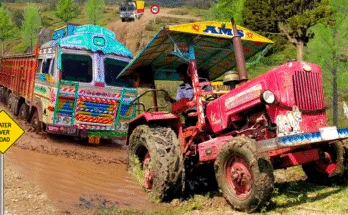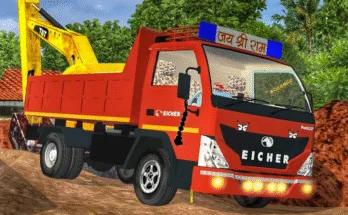Tractor Pulling Truck Bus Game I. Introduction: The Unleashing of Power
Tractor-pulling simulation games have garnered a niche following, captivating players with their unique blend of raw mechanical power, precision driving, and the mastery of handling heavy-duty machinery. These games provide a fascinating experience for fans of motorsports and mechanical engineering, offering a taste of the thrilling competition and skill required to drive tractors in tractor-pulling events. A perfect example of this genre is Real Offroad Tractor Pulling Simulator (com.rs.real.offroad.tractor.pulling.simulator). The game promises to deliver an immersive experience centered around tractor pulling, where players test their ability to control powerful machines across challenging terrains. This article will delve into the game’s core mechanics, explore the cultural significance of tractor pulling and rural life, speculate on potential monetization strategies, hypothesize how players may receive the game, and reflect on its place within the broader simulator genre. In doing so, comparisons will be drawn with similar titles such as Tractor Pull or Monster Jam to highlight its unique appeal.
II. Core Gameplay Mechanics: Harnessing Power and Precision
Tractor Variety:
In Real Offroad Tractor Pulling Simulator, we can expect a range of tractor types, likely modeled after real-world machines. These could include renowned brands like John Deere, Case IH, Massey Ferguson, and New Holland. The game may offer different classes of tractors, such as light modified, super stock, and heavy modified, each with distinct capabilities and visual characteristics. For instance, light modified tractors may be designed for precision, whereas heavy modified ones would focus on raw power.
Engine and Performance Specs:
Tractor pulling is all about maximizing engine performance, with tractors often sporting high-powered engines-ranging from turbocharged four-cylinder units to multi-engine setups. These configurations allow for an extraordinary amount of horsepower, torque, and boost pressure. The game will likely attempt to replicate this by modeling realistic engine sounds, torque curves, and the dynamics of power delivery. Players will need to carefully monitor their tractor’s performance, adjusting for factors like engine revs, turbo boost, and power distribution to achieve optimal pulls.
Towing Mechanics:
The core of tractor-pulling gameplay involves towing a weighted sled down a dirt or mud track. As the sled’s weight increases, so too does the resistance, and players must maintain control while managing the increased strain on their tractor. The game may include mechanics that simulate tire spin, weight transfer, and throttle control, allowing for a realistic and immersive experience. The sled’s increasing resistance would require players to adjust their technique, such as shifting weight and controlling speed, making every pull a test of skill.
Terrain and Tracks:
The game could feature various track types, from well-packed dirt to slippery mud. These different surfaces would challenge the player’s ability to maintain traction and manage their tractor’s power effectively. For example, muddy tracks may reduce tire grip, forcing players to adjust their speed or weight distribution for better performance. The game may also introduce track conditions such as dry, loose dirt or even clay, each requiring a unique approach to tractor control.
Pulling Technique:
Tractor pulling requires more than just brute strength. Real-life drivers rely on precise throttle control, weight transfer, and careful steering to optimize their tractor’s performance. In Real Offroad Tractor Pulling Simulator, players will likely need to master these techniques, adjusting their approach based on factors like tractor type, track conditions, and sled load. Learning how to shift weight forward or backward, adjusting the throttle for maximum traction, and maintaining a straight line down the track will be crucial for success.
III. Cultural Resonance: Honoring the Rural Spirit
The Allure of Tractor Pulling:
Tractor pulling has deep roots in agricultural communities, where it began as a competition to demonstrate the power and durability of farming equipment. Today, it represents values of hard work, mechanical ingenuity, and community pride. Real Offroad Tractor Pulling Simulator taps into this cultural heritage by offering players a chance to engage with a beloved rural tradition in a digital format. The game likely appeals to players who are either directly involved in agriculture or have an affinity for rural life.
Rural Communities:
Beyond the machines themselves, tractor pulling is a celebration of rural life. The tight-knit nature of these communities, where farmers often gather for local events, is a key aspect of the sport. The game may offer a glimpse into these communities, potentially including visuals of rural landscapes, farmsteads, and agricultural festivals. This representation would serve to reinforce the connection between the game and the real-world traditions it reflects.
Authenticity and Respect:
In representing rural culture, the game must tread carefully to avoid stereotyping. A respectful portrayal of agricultural life, its challenges, and its values will be crucial for resonating with players who identify with this lifestyle. The developers should aim to capture the spirit of the community while avoiding caricatures or over-simplifications, ensuring that the game honors the authenticity of the rural experience.
IV. Monetization and Progression: Driving Success
Free-to-Play Elements:
Given the mobile platform, Real Offroad Tractor Pulling Simulator may adopt a free-to-play model with in-app purchases. These could include cosmetic upgrades, such as custom tractor skins, or performance boosts, like engine parts or enhanced tires. While these microtransactions would help sustain the game’s revenue, balancing them to avoid pay-to-win scenarios will be key to maintaining player satisfaction.
Progression System:
The game may include a progression system where players can upgrade their tractors over time. This could involve unlocking new tractor models, engine parts, or performance enhancements. Players would likely earn in-game currency through successful pulls, which they can then invest into tractor improvements. A well-balanced progression system would keep players engaged and provide a sense of achievement as they build their virtual tractor empire.
Monetization and Balance:
Monetization must be carefully balanced to ensure that players don’t feel pressured to spend money to progress. A fair system would allow both paying and non-paying players to enjoy the game equally, with the option to purchase cosmetic items or quality-of-life improvements without giving paying players an unfair advantage in gameplay.
V. Speculating on Community: Fostering a Digital Pit Crew
Anticipated User Reviews:
Players’ reactions to the game will likely be mixed. Enthusiasts of tractor-pulling may appreciate the attention to detail, but some could criticize the game for being too niche. Positive reviews will likely praise the realism of the gameplay and the unique experience, while others may note the limited appeal for those outside the rural community.
Social Media Presence:
Players may take to social media to showcase their achievements or share tips on mastering specific pulling techniques. Customizable tractors, in particular, could generate a lot of user-created content, as players compete to build the most powerful or visually unique machines.
The Developers’ Response:
Active developer engagement with the community will be important. The developers could engage with feedback on forums or social media, release updates based on user suggestions, and organize in-game events like competitions or tournaments. This would foster a loyal and engaged player base.
VI. Anticipated Technical Elements: Crafting a Realistic Experience
Visuals and Auditory Details:
The visual representation of tractors, tracks, and environmental effects (e.g., dust, mud splashes, engine smoke) will be crucial for immersion. The game could include detailed tractor models with realistic textures and animations, as well as dynamic camera angles that allow players to view their machines from various perspectives.
Performance and Optimization:
Optimizing the game for smooth performance across a range of mobile devices will be essential. The developers will need to strike a balance between graphical fidelity and performance to ensure the game runs well on both high-end and lower-end devices.
VII. Comparing Real Offroad Tractor Pulling Simulator to Its Competition
Comparative Analysis:
Compared to other simulation games like Monster Jam or Tractor Pull, Real Offroad Tractor Pulling Simulator offers a more focused and authentic portrayal of tractor pulling. While other games may feature monster trucks or abstract pulling mechanics, this game is likely to appeal to a smaller, more dedicated audience seeking a true-to-life experience.
Strengths and Weaknesses:
Strengths may include a niche appeal and detailed gameplay mechanics, while weaknesses could involve a limited target audience and potential overspecialization. The game will have to find ways to broaden its appeal while maintaining its authenticity.
VIII. Long-Term Prospects: Powering Forward
Extending Gameplay:
The longevity of the game will depend on continuous updates, including new tractor models, tracks, and event types. Seasonal tournaments or limited-time challenges could also keep players engaged long-term.
Potential Updates:
Adding new tractor manufacturers or more intricate customizations could keep the gameplay fresh. Updates that introduce new features or mechanics, such as dynamic weather, could also add variety and extend the game’s appeal.
Community Engagement:
The developers could foster a sense of community by hosting online events, offering leaderboards, and enabling social features such as player-to-player competitions or shared custom tractors.
IX. Reflecting Rural Values in a Digital World
Honoring Rural Life:
This game serves as a tribute to rural life and the hardworking individuals who participate in tractor-pulling events. By capturing the essence of these traditions and offering an immersive digital experience, Real Offroad Tractor Pulling Simulator can help preserve the values of agricultural communities for a new generation.
X. Frequently Asked Questions (FAQ)
Q: Is this game fun to play?
While the enjoyment will vary based on personal interest, fans of tractor pulling and simulation games will likely find the experience engaging, especially for those who appreciate mechanical challenges and precision driving.
Q: What tractors will be in the game?
The game may feature iconic tractors from manufacturers like John Deere, Massey Ferguson, and New Holland, with a focus on different tractor classes such as light modified and super stock.
Q: Will there be multiplayer modes?
While real-time multiplayer could be challenging due to the nature of the gameplay, asynchronous multiplayer modes, such as leaderboard challenges or time trials, might be included.
Q: How is this game different from other simulator games?
Unlike generic simulation games, Real Offroad Tractor Pulling Simulator focuses on the specialized sport of tractor pulling, offering players an authentic and niche experience not found in most simulators.
XI. Potential Features: Enhancing Realism and Engagement
Dynamic Weather and Terrain:
Introducing variable weather conditions, such as rain or snow, could affect track conditions and force players to adapt their strategies accordingly.
Detailed Tractor Customization:
Allowing players to customize tractor parts, from engines to tires, could provide greater control over performance and appearance.
Realistic Physics Engine:
A physics engine that accurately simulates the weight transfer, traction, and power delivery of tractors will add depth to the gameplay, making each pull feel more real.
XII. Conclusion: Honoring Strength and Skill
Real Offroad Tractor Pulling Simulator is poised to carve out a niche in the simulation genre, offering players an immersive and authentic tractor-pulling experience. While the game will likely appeal most to fans of rural life and motorsports, its unique gameplay and deep mechanics could resonate with a broader audience, provided the developers balance realism with accessibility. By staying true to the spirit of tractor-pulling competitions and providing ongoing content updates, this game has the potential to thrive within its niche and perhaps even expand its reach beyond enthusiasts.



